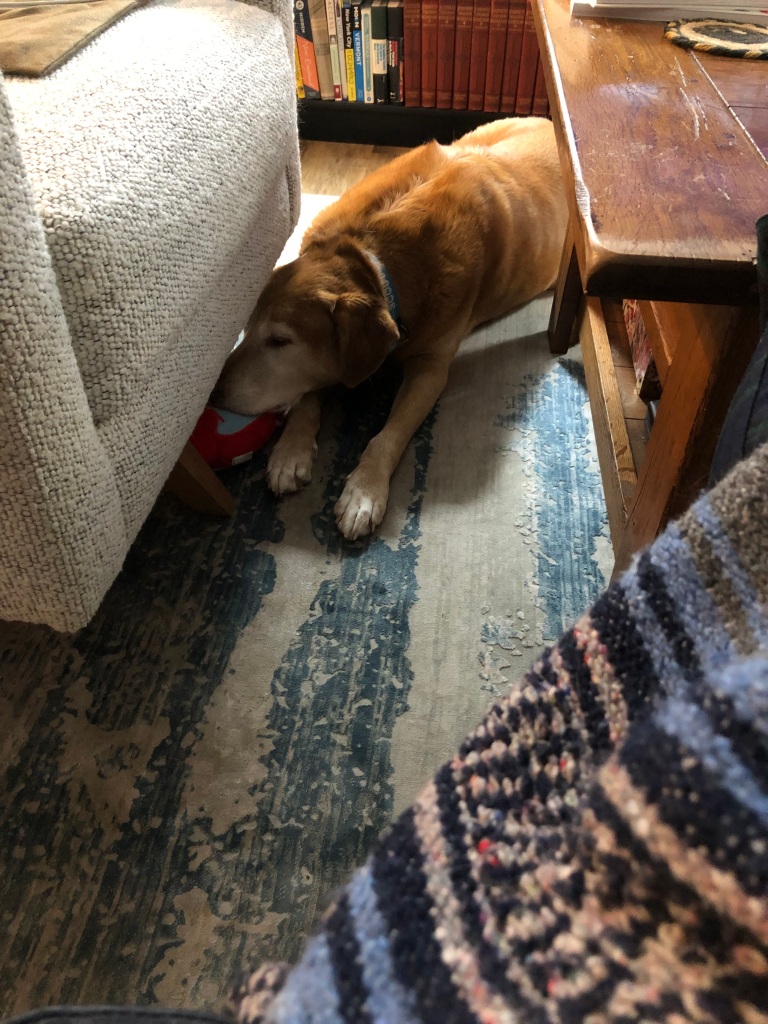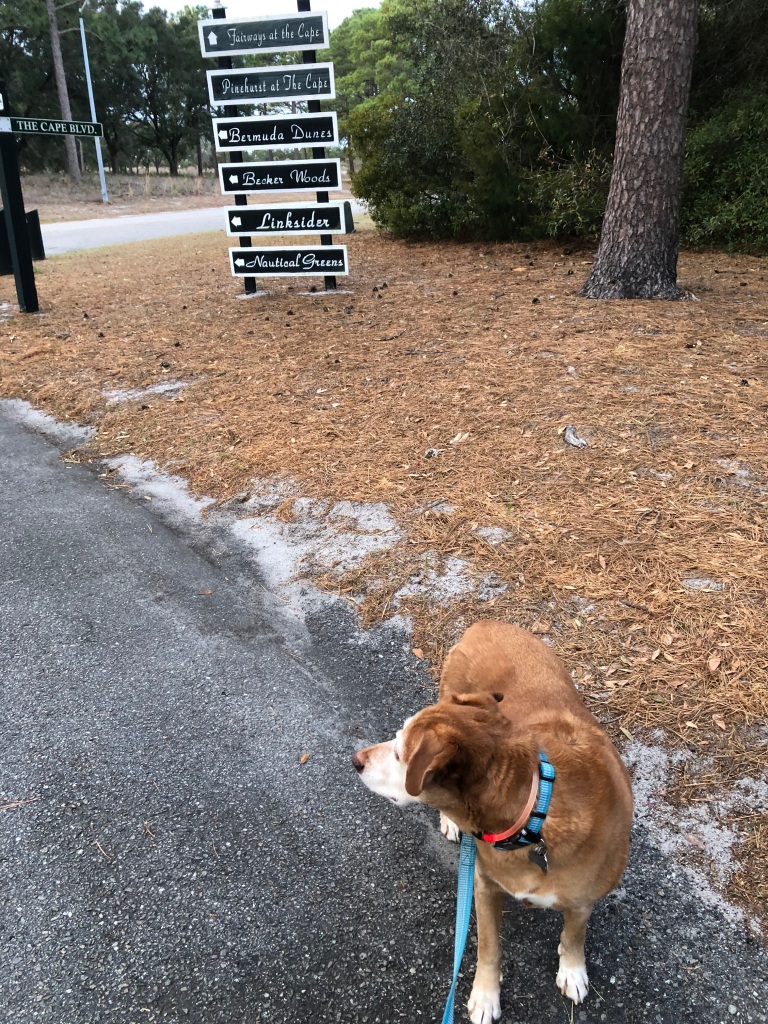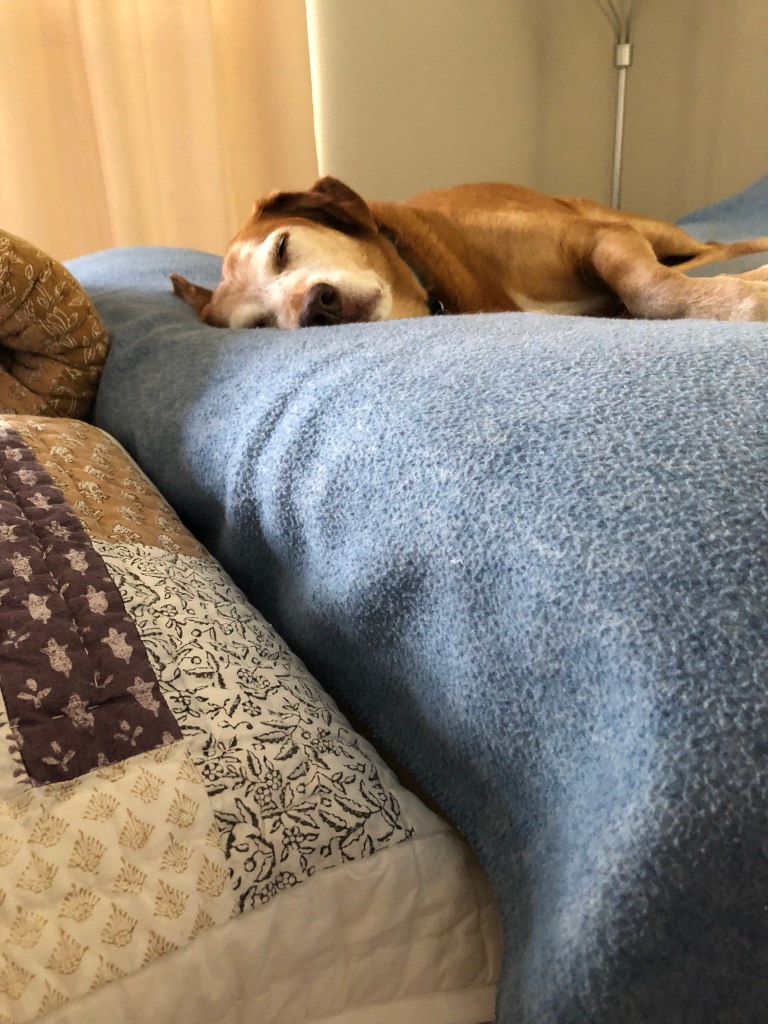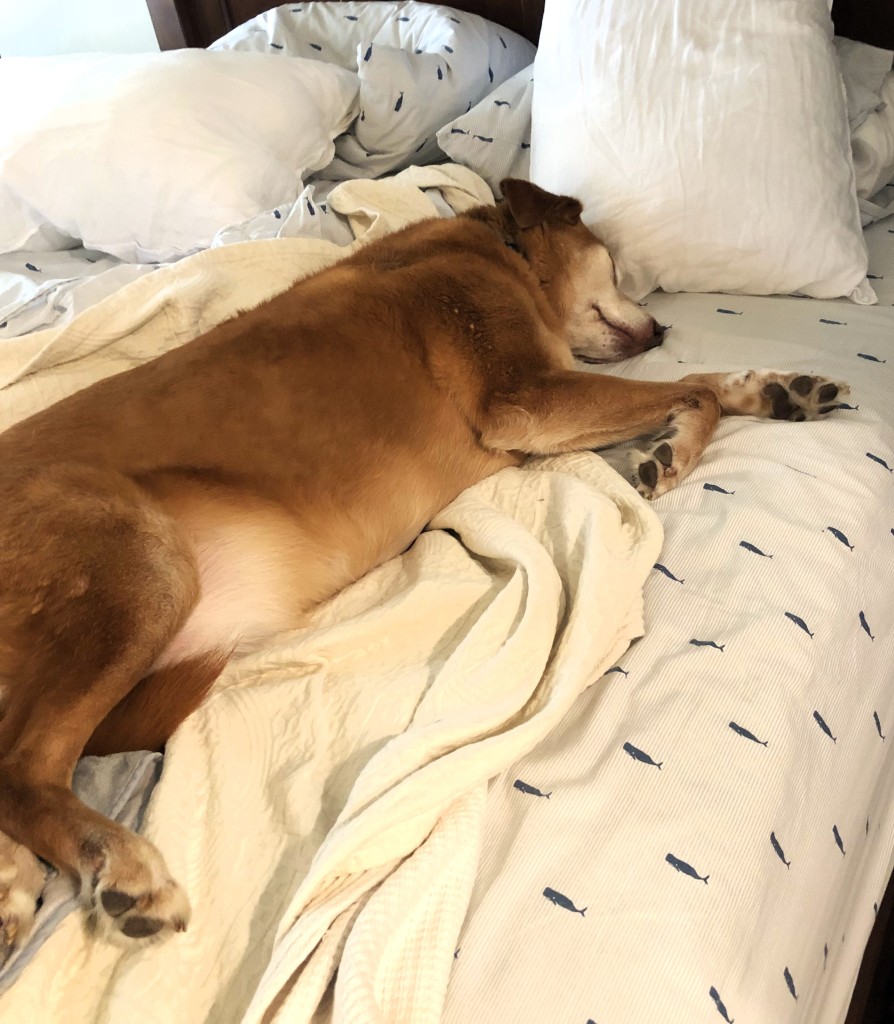
Some 900-plus days into our tenure in coastal North Carolina, and I believe this dog has finally made his peace with the sometimes-oppressive humidity, the stormy nights, rambunctious neighborhood kids, the unpredictable action of the ocean on a good beach day, and all the rest. And while he may not have whole-heartedly embraced all these conditions in his life, like most dogs living their best lives (we think he is, anyway), tawny Scout—now an old man—mainly just wants to be with us, with a caveat or two.
Here is one. In the high summer heat, he comes out onto the screen porch with us for a minute, and then nudges the door open with his snout and goes back inside. It is too damned hot. One of us gets up to close the door behind him so we don’t air condition all of Wilmington. Soon, his face reappears at the French windowpane, beseeching. If there is no action, he thwaps the door with a heavy paw; when there is still no action, he speaks: Could one of you old coots get up and let me out? One of us does. This repeats for a while, recalling T.S. Eliot’s Rum Tum Tugger, always on the wrong side of every door, kind of thing, until we finally come inside, or until Scout gives up and moves himself to the coolness of our bedroom, under the whirring ceiling fan. As one of my coworkers who understands dogs likes to say, I want to be with you where I want to be.
Stranger in a Strange Land

“He came to us from a Texas rescue, so I don’t know about this kind of cold.” I worried aloud about this during one of the first visits to our Vermont veterinarian in early 2019.
She finished poking our new and mainly patient doggy and now applied her stethoscope to his chest.
“He came to you from Texas and thanks you very much,” she quipped. “He is a heavily muscled dog and has trouble getting rid of heat—he will love this kind of cold.”
This was news to me after living in the Appalachian South with four Siberian Huskies and a couple of shepherds over several decades, one of them a giant breed, and all of them dogs you’d associate more with cold climates. But in truth I never had much trouble with those doggies in the heat, even running with them. Their coats and inner thermostats just seemed to adapt, somehow.
Not so much the case for Scout, who arrived in Vermont on a record-breaking cold December day with cruel wind, wouldn’t you know. We worried, but at the time didn’t yet understand this dog who genuinely hates hot weather. First time we had a deep snow, I had a tough time convincing him to come inside. Just let me roll around in this stuff one more time, one more time, and then we can go in, he beseeched.
I could run miles with Scout in below-freezing weather, but in the delicious warmth of summer? Forgetaboutit. His reaction was simply to stop and stand there on the side of the road, unwilling to budge. Naturally, this typically occurred at the farthest point from our house (or car) and so I had little choice except to wait him out, and then walk the rest of the way with him, haltingly, waving at passersby with my own tail tucked.
Scout Has Lumps & Bumps, But Our Local Vet ‘Gets’ Him
We moved to North Carolina from a rural New England state where you go to the one veterinary practice that’s not a 45-minute drive away, and you’re just happy they exist at all. Fortunately, the practice closest to home in Vermont was fantastic. Those vets understand the challenges Vermont-ish dogs face, and nothing ever seems to impress them too much. One time during a diagnostic follow-up visit to a vet over in the Upper Valley, where I lived for a short time with my German Shepherd Clarence, she tried to steer my head away from the death sentence I knew was coming (yes, he probably had degenerative myelopathy), pointing out how healthy his hips looked on the x-rays. So many ironies for a dog who could easily run the five-mile circuit around the lake where I lived that first difficult year, and might’ve willingly gone around again if I asked.
Then came floppy-eared Scout, who was not so sure about this thing called gofera run. “Try to take him somewhere he can run off-leash,” our vet implored after I explained my running habit. “Dogs aren’t really built for distance running. But if he can stop and sniff and fall behind a little, and then catch up to you, and then repeat, etc., that’ll be better for you and ideal for him.”
In our crowded coastal North Carolina town, there is seemingly a veterinary hospital on every corner, but I can’t imagine a doctor at any one of them suggesting that (and it would be idiotic to attempt in a region alligators call home, but somehow people still do). We did find a good doctor though, eventually, one who gets us and our white-faced fella.
She gave Scout a clean bill of health despite his “lumps and bumps,” as she called them, at his wellness check in December. He has one biggish lump-or-bump that has grown impressively to about the size of a softball in recent years. We had it biopsied in Vermont when it was more like a walnut, and it was deemed benign, just a plain old lipoma. Sometimes we call it Fred. Our vet here agrees there is no need to remove it, unless and until it begins to affect his mobility (it’s kind of tucked in front of one hip). So on he marches into his golden years with all his lumps and bumps, and don’t we all.
We Can Still Run (But We Don’t Have to Like It)

Our first two years in North Carolina I simply stopped running with Scout, ever, in the heat of summer, and satisfied myself he was getting enough exercise with a daily walk in the evening and during his one long day at dog ‘camp,’ mid-week. Winter, though, remained his season. On the coldest days he could and still can run three miles like he’s a juvenile.
Lately though, now that camp’s out of the weekly mix thanks to the mystery canine virus that can kill, I’ve been noodling on how best to keep him moving. If I learned anything from a lifetime immersed in classical ballet, it’s that staying mobile is essential, not just for longevity, but for the quality of life we all want. So the question is, how can I run with Scout during summer here?
Here is what seems to work right now. Three mornings a week (the goal) I take Scout for a brisk run in the darkness of the very early morning, for exactly one mile. I drop him back at the house, and then continue on my way to satisfy my need for a much longer run. It is still hot, but there is no sunshine beating down on us at that hour, and occasionally there is even a cool breeze. Today, magically, we managed a mile in the much later morning, in sunshine-y 78° heat and 90% humidity, said Alexa when I asked her. This makes me think the strategy is working, and that Scout is adapting. It’s enough to tucker him out and, significantly, to keep him from pouting when I turn around and strike out again without him. If you’ve been in my shoes, you know that look and understand how it can rip out your heart.
You must make the right decision for your dog, a Knoxville veterinarian once told me, because she’s probably going to say “yes” when you ask the question, even if it’s not in her best interests.
Sooner or later, I know Scout won’t be able to manage even a mile—I know, from running with various large dogs through the decades. They’ll eventually tell you when it’s enough, and then when it’s just too much. I’d like to think I’m a smarter animal steward these days, though; I started giving Scoutie his preventive ‘cocktail’ a few years ago, before he was showing any signs or symptoms of arthritis. Best to get out ahead of it than to try to catch up later on, went my thinking. For the time being, he can still load up into the back seat of my SUV like he’s levitating, and can hop onto the impossibly high bed in one of our guest bedrooms like nobody’s bidness. I’m not seeing lameness in this dog, not yet.
My Sleep Habits Are Mine, You Humans Be Damned

But we think he sees lameness in this pair of humans who complete his pack. When he first arrived, he slept in a crate on the main level of our teeny Vermont rental house in the woods, separated from us by an irksome spiral staircase no dog worth his own salt would attempt (Clarence-the-Canine before him also refused). But a year or two later, after we bought a proper ‘New Englander’ in town, all bets were off. The first night there he bounded joyously onto our bed, and slept long hours with us, until overheating compelled him to jump down and seek the comfort of his own bed. This became his habit.
Lately, though, Scout has decided sleeping in our bed is undesirable (our new platform bed, one we chose in part because we felt it’d be easier for him to navigate as an older dog). Not only that, sleeping in our bedroom is evidently undesirable—and not only that, but sleeping on the same level of the house with us is no longer acceptable. Instead, he comes into the bed with us for about a minute for a chin scratch, maybe a belly rub, and then tells us, unceremoniously, gotta bounce. Up the steps he bounds, into the bigger of the two bedrooms on the second level, and up, up, up onto the high bed, where he stays for the duration. I’ve finally stripped it of all the bedding and thrown a big blanket on it—now ‘Scout’s blanket’—to catch all the hair and such.
For a time, I worried maybe we were seeing the onset of canine dementia. Now I think he comes upstairs to sleep because, simply, reasons. For this timid old man, one who’s always startled easily, I think, meh, let him do what he wants. He knows his mind.
Scout’s Still Here
As Stephen Sondheim might’ve said.
The food is great, and the service is okay. The routine is predictable, but that’s how we like it.
Here is one of those predictable routines. Our favorite neighbor dog, Jerry, is a six-year-old American Foxhound who lies in his driveway on fair-weather days, alert, paws crossed, waiting each evening for Scout and other passersby to come see him for a shake-and-howdy. Jerry has a patriotic bandana tied around his neck and looks like he’s wearing eye liner under his impossibly alluring brown eyes. He is slender, but like Scout, is sinewy and muscular and has white socks and a creamy white bib; sometimes his human, Vinny-from-Jersey, is sitting out there with him, reading, but if he is not, often sprints outside when he sees us to say hello. Other times Vinny waits for us to come by so Jerry can have his visit with Scout, before taking him inside for the night. If we walk by without stopping, Jerry bays at us until we relent, but Scout won’t linger too long, because there are mailbox posts yet to sniff and mark (Scout-was-here), and squirrels to tree.
This is Scout’s life as a senior doggo in coastal North Carolina.
At home, I cup his chin and look into his face and point out the obvious, Life is pretty good. He wags in agreement.


I’m sure that Scout is having the best time ever – despite the heat of NC. I had to smile about his lumps and bumps because my pup Mochi has one in a similar spot and it is a lipoma too. Luckily it hasn’t grown much in 2 years and is still the size of a grape.
LikeLike